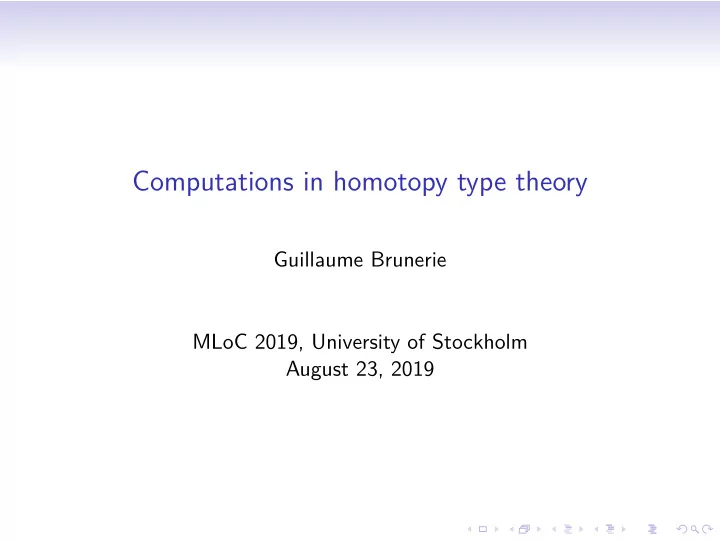

Computations in homotopy type theory Guillaume Brunerie MLoC 2019, University of Stockholm August 23, 2019
Constructivity of Martin–Löf type theory Theorem Take u a closed term of type N in MLTT, and successively apply reduction rules to u . Then • this procedure terminates, • the order of the reductions does not matter, • the result is a numeral (of the form S ( . . . ( S (0)) . . . )). The last point (canonicity) does not work in the presence of axioms.
Homotopy type theory Homotopy type theory (HoTT) is MLTT + Univalence axiom (+ Higher inductive types) The presence of an axiom destroys the canonicity property. There are closed terms of type N which are stuck but are not numerals.
Homotopy type theory Homotopy type theory (HoTT) is MLTT + Univalence axiom (+ Higher inductive types) The presence of an axiom destroys the canonicity property. There are closed terms of type N which are stuck but are not numerals. Nevertheless, univalence “feels” constructive. Homotopy canonicity (conjectured by Voevodsky, 2010?) Given a closed term u : N , there exists a closed term k : N and a proof p : u = N k , where k does not use univalence.
Constructivity of homotopy type theory There are now many results giving some constructive nature to some version of HoTT:
Constructivity of homotopy type theory There are now many results giving some constructive nature to some version of HoTT: → First cubical model (BCH)
Constructivity of homotopy type theory There are now many results giving some constructive nature to some version of HoTT: → First cubical model (BCH) → Cubical type theories and more cubical models (CCHM, ABCFHL, OP, ACCRS)
Constructivity of homotopy type theory There are now many results giving some constructive nature to some version of HoTT: → First cubical model (BCH) → Cubical type theories and more cubical models (CCHM, ABCFHL, OP, ACCRS) → Homotopy canonicity (Sattler-Kapulkin, not yet constructive)
Constructivity of homotopy type theory There are now many results giving some constructive nature to some version of HoTT: → First cubical model (BCH) → Cubical type theories and more cubical models (CCHM, ABCFHL, OP, ACCRS) → Homotopy canonicity (Sattler-Kapulkin, not yet constructive) And work in progress towards constructive simplicial models (GH, vdBF).
Implementations Many implementations have been written:
Implementations Many implementations have been written: → cubical (implementation of the first cubical model from BCH)
Implementations Many implementations have been written: → cubical (implementation of the first cubical model from BCH) → cubicaltt (cubical type theory from CCHM)
Implementations Many implementations have been written: → cubical (implementation of the first cubical model from BCH) → cubicaltt (cubical type theory from CCHM) → redPRL (cartesian, and in the style of Nuprl)
Implementations Many implementations have been written: → cubical (implementation of the first cubical model from BCH) → cubicaltt (cubical type theory from CCHM) → redPRL (cartesian, and in the style of Nuprl) → yacctt (cartesian cubical type theory)
Implementations Many implementations have been written: → cubical (implementation of the first cubical model from BCH) → cubicaltt (cubical type theory from CCHM) → redPRL (cartesian, and in the style of Nuprl) → yacctt (cartesian cubical type theory) → redtt (successor of redPRL)
Implementations Many implementations have been written: → cubical (implementation of the first cubical model from BCH) → cubicaltt (cubical type theory from CCHM) → redPRL (cartesian, and in the style of Nuprl) → yacctt (cartesian cubical type theory) → redtt (successor of redPRL) → cubical Agda (based on CCHM and Agda)
π 4 ( S 3 ) Proposition (2013) One can construct a natural number n such that π 4 ( S 3 ) ≃ Z / n Z .
π 4 ( S 3 ) Proposition (2013) One can construct a natural number n such that π 4 ( S 3 ) ≃ Z / n Z . Proposition (2016) Moreover, n = 2.
π 4 ( S 3 ) Proposition (2013) One can construct a natural number n such that π 4 ( S 3 ) ≃ Z / n Z . Proposition (2016) Moreover, n = 2. Open problem Compute the value of n directly. (And we tried! But all of our experiments, using the various implementations, ran out of either memory or time.)
The definition Ω 3 e Ω 3 α Ω 2 ϕ S 2 λ n . loop n Ω ϕ S 1 Ω 3 ( S 1 ∗ S 1 ) Ω S 1 Ω 2 S 2 Ω 3 S 3 Ω 3 S 2 Z h Ω 3 ( S 1 ∗ S 1 ) Ω 3 S 3 Ω 2 � S 2 � 2 Ω � Ω S 2 � 1 � Ω 2 S 2 � 0 Ω S 1 Z e 3 κ 1 , Ω S 2 e 2 e 1 Ω 3 e − 1 Ω κ 2 , S 2 n is the absolute value of the image of 1
Recommend
More recommend